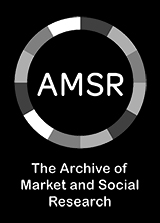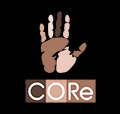GKB: Geodemographics Knowledge Base
Geodemographics
Geodemographics is the description of people according to where they live, derived from the study of spatial information.
Booth's Life and Labour Survey
In the BBC Radio 4 programme ‘In our Time’, Melvyn Bragg and guests discuss Charles Booth's ambitious project to discover how many people in late Victorian London were living in poverty, and understand why. The Life and Labour of the People in London, published in 17 volumes from 1889 to 1903. Booth (1840-1916), a Liverpudlian shipping line owner, surveyed every household in London to see if it was true, as claimed, that as many as a quarter lived in poverty. He found that it was closer to a third, and that many of these were either children with no means of support or older people no longer well enough to work. He went on to campaign for an old age pension, and broadened the impact of his findings by publishing enhanced Ordnance Survey maps with the streets coloured according to the wealth of those who lived there.
The History of Geodemographics: The Future of GeoDems: 28th January 2021
This link plays the recording of a CGG event held in January 2021 to mark the 20th anniversary of the Geodems Knowledge Base. There were two main speakers – Dr Barry Leventhal and Professor Paul Longley.
Dr Leventhal discussed how the geodemographics industry got started in the UK, the main changes that have taken place leading to the current thriving marketplace, plans for the census and potential change in the future.
Professor Longley described some of the ways in which consumer data are supplementing more conventional data sources in the creation and updating of geodemographic indicators.
For a summary report on the webinar, go to separate GKB entry: Mapping with more: 20 years of geodemographics.
The Future of Geodemographics
An article by Dr Barry Leventhal, published in Research Live in January 2021, which overviews the geodemographics industry in the UK, the plans for the 2021/2022 UK censuses, and the possibility that the traditional census will be replaced by administrative data in the future.
AMSR: 40 years of Geodemographics
February 2019 Article
Barry Leventhal writes about 40 years of Geodemographics for the AMSR (Archive of Market and Social Research) newsletter.
BBC Radio - Thinking Allowed – Maps and Postcodes
Is there such a thing as a predictive postcode? Can it reveal more about us than our bank account, ethnicity or social class? Laurie Taylor poses the question to Roger Burrows, Professor of Cities at Newcastle University. Also, Mapping Society - Laura Vaughan, Professor of Urban Form and Society at the Bartlett School of Architecture, UCL, examines how maps not only serve as historical records of social enquiry, but also reveal the ways in which difference and inequality are etched deeply on the surface of our towns, villages and cities.
Location Intelligence in Public Sector
Location intelligence is helping local governments make timely and accurate decisions and drive digital engagement.
Location-based advertising
Location-based advertising hinges around the fact that wherever people go these days they always carry a mobile with them. And most quite happily share out location data with the various apps they use. This presents an opportunity for advertisers to personalise their messages to people based on their current location. In real time
Geodemographics for Marketers: using location analysis for research and marketing
Geodemographics for Marketers is being published by Kogan Page early in 2016.The book has been written to provide marketing professionals and students with the know-how to leverage geodemographics techniques, and demonstrates their many applications and benefits. The author is Barry Leventhal, and the book includes articles and case studies contributed by a wide range of experts.
Open Geodemographics
A ‘portal' featuring geodemographic products created with open methods, data and tools by researchers from the University of Liverpool and University College London. The products and the underlying data are free to download and use, including commercial applications. The researchers add that methods are transparent and reproducible, with products supported by an active user community, and available to modify and augment. The website currently features the UK Output Area Classification (OAC) built in partnership with the ONS and created entirely from the 2011 census data, the bespoke London Output Area Classification (LOAC), and the Temporal Output Area Classification (TOAC) exploring geodemographic change between 2001 and 2011. A linked website has interactive and searchable maps of each classification down to very local levels.
Bluewave Geographics
Bluewave Geographics is a provider of digital mapping and geographical analysis services to the market research and fieldwork sectors with experience in the areas of spatial analysis, mapping, geo-demographics, survey design and sampling.
Personicx
Personicx is a consumer segmentation produced by Acxiom. It utilises a wealth of demographic, geographical, lifestyle and behavioural information to segment the UK market place into 55 robust clusters, allowing you to effectively understand, target and connect with consumers. As the number of touchpoints continues to grow, digital identities and behaviours evolve. Personicx now includes a vital digital dimension allowing users to plan marketing engagements effectively across channels.
TRAC - The Research and Analysis Consultancy
The Research and Analysis Consultancy specialises in the statistical analysis of customer data to improve marketing effectiveness. TRAC helps companies to better understand their data and how it can be used to increase profitability. Sonar is a truly unique and powerful segmentation system that classifies all households and residents in the country according to the type of neighbourhood in which they live.
A Landmark paper: the first step towards big data?
Read Peter Mouncey's blog piece regarding his selection of a landmark paper from the International Journal of Market Research archives: The utility to market research of the classification of residential neighbourhoods - Ken Baker, John Bermingham and Colin McDonald, BMRB (published in the Journal of the Market Research Society, Vol.39 No. 1, January 1997).
ABS - Australia's National Statistical Agency
The Australian Bureau of Statistics (ABS) is Australia’s national statistical agency. The ABS provides key statistics on a wide range of economic, environmental and social issues. The ABS also plays an important leadership and coordination role in relation to the statistical activities of other official bodies, both within Australia and internationally. The Census of Population and Housing is the largest statistical collection undertaken by the ABS and is conducted every 5 years. The last Census was in 2011.
UK Geographics
UK Geographics is a provider of sampling and fieldwork solutions for Market Research and Field Agencies in the public and private sectors.
GeoTribes
GeoTribes is a person-level segmentation system that operates across multiple countries
AFD Software: Censation
Censation is a geodemographic solution based on 2011 Census data and other sources. It is included free of charge in all of AFD's Address Management Products.
CAMEO Segmentation
The CAMEO product was built by Callcredit and continues to be offered by TransUnion. TransUnion acquired Callcredit in 2018.
Demographic Decisions
Demographic Decisions provide independent consultancy advice to companies and organisations looking to maximise the value of their investments in demographic data and data exploitation.
Experian Consumer Segmentation
The home page for Mosaic and other segmentation systems from Experian.
GeoConnexion UK Magazine
GeoConnexion UK cover news, features devoted to the UK's GI industry. Its special focus are on E-Government, Health, Public Saftety, Retail, Environmental, Utilities, Surveying, Location-Based Services, Tranport/Logistics and Telecommunications. It is published in both hardcopy and online versions.
GRC Data Intelligence
GRC Data Intelligence is an independent consultancy and information provider, specialising in international data knowledge. This site also contains the most complete postal code and address resource list available.
Internet-based neighbourhood information systems and their consequences
This study (from 2005) from the Joseph Rowntree Foundation looks at the emergence of internet-based information systems (IBNIS), examining a range of sites in detail. Based on interviews with those involved in the development of such sites in the UK and USA, it looks at how technology can be used to classify and sort people and places.
Maptitude
The Maptitude GIS for Windows is a low cost mapping solution for business, government, and education from Caliper Corporation. The software is available bundled with postcode boundaries (to sector level), postcode locator tools and a range of demographic and mapping datasets.
2011 Census area classifications
This page from the ONS website provides information on the area classifications derived from 2011 Census data.
OCSI, Oxford Consultants for Social Inclusion
OCSI can help local government and other public sector organisations develop detailed area profiles, providing information and analysis needed for area based strategies.
OriginsInfo
OriginsInfo specialises in geodemographics and the production of geodemographic software tools. Their key product, Origins, is a segmentation tool that helps organisations to understand the cultural, ethnic and linguistic origins of their users, customers, clients and employees.
Society for Location Analysis (SLA)
The Society for Location Analysis is a not-for-profit networking group for professionals working in location analysis. The SLA offers its members the opportunity to network, keep up-to-date with new technology and changing trends and to learn new skills at workshops and seminars.
Improving Visualisation - Southwark Atlas of Health (annotated map)
This website illustrates the use of geodemographics in health by presenting case studies of real targeting campaings in Southwark as well the underlying theory.The website is an outreach activity of a Knowledge Partnership between UCL CASA Centre for Advanced Spatial Analysis and the NHS.
The project is based in Southwark Primary Care Trust.
Who's in? Lifestyles data and geographical research - Year 2000
A paper by Rich Harris in which he considers the potential for the application of lifestyles data in geographical research, and in particular within geocomputational problems. Issues such as geographical bias in non-response and the unknown quality of the data are tackled from an academic perspective.
Guardian Article - England's most deprived town
This article from The Guardian describes how a seaside town in Essex has the highest levels of deprivation in the country as measured by the Government's Indices of Deprivation 2010 for England. In the article are links which enable you to explore the Indices of Deprivation in greater detail, including access to the underlying data and maps. There is an interactive map which combines Google Maps with the Government’s (DCLG) Indices of Deprivation 2010 for England. The geographical unit is Lower Layer Super Output Area (LSOA) and clicking within an LSOA gives a pop-up with a deprivation score and rank plus a partial guide to the categories on the map.
Mapping with more: 20 years of geodemographics
A summary report on the MRS webinar celebrating 20 years of the Geodems Knowledge Base, published in Research Live in February 2021. The webinar examined how the geodemographics industry is evolving and discussed ways in which the conventional data is being supplemented by consumer data.
For the recording of the webinar, go to separate GKB entry: The History of Geodemographics: The Future of GeoDems: 28th January 2021.
Get the latest MRS news
Our newsletters cover the latest MRS events, policy updates and research news.










